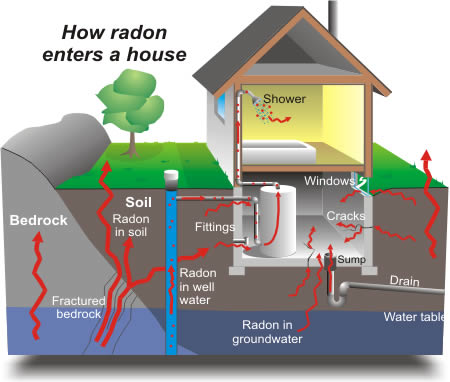What is radon gas?
Radon is a radioactive gas that comes from the ground. It is formed as a product of the breakdown of uranium in the soil. It is invisible, odourless, and tasteless and can seep into buildings undetected in areas where the house comes into contact with the ground.
What are the Health Effects of Radon Gas?
In the outdoors, radon dissipates safely as it is diluted by outdoor air. Radon poses a serious health risk when it accumulates in buildings because long-term exposure to high levels of radon for an extended period of time can cause lung cancer. In Canada, radon gas is the second leading cause of lung cancer.
Health Canada estimates that about 16% of lung cancer deaths (~3,200 per year) in Canada are attributed to radon. The risk of cancer depends on:
- the level of radon gas in your house
- how long you are exposed to it
- whether you smoke since exposure to radon and smoking tobacco together can significantly increase your risk of developing lung cancer
How Does Radon Enter My Home?
Radon is harmless outdoors because it dissipates in outdoor air. In buildings, radon can seep in and accumulate undetected through areas where the house comes in contact with the soil. Possible entry points into include cracks in foundation walls and floor slabs, construction joints, gaps around service pipes, support posts, window casements, floor drains, sumps or cavities inside walls, dirt floors etc.

A number of factors can affect radon levels in a building. High radon levels can occur in any building regardless of age, heating system, foundation type, geographic location, air tightness, ventilation rate or building materials used.
The amount of radon in your home will depend on:
- the source (amount of uranium in the ground),
- the number of entry points into your home,
- how well your home is ventilated among other factors.
What Should I do to Protect Myself from Radon Gas?
The problem with radon is that you can’t see, taste or smell it. There are no definitive sysmptoms that result from exposure to radon gas either. Radon gas exists to some extent in every home in Canada. The question is, how much is in your home?
The only way to know is to test your home!
Radon Testing in Canada
Testing your home is easy:
- You can use a home radon testing kit to test your home : these kits come with a radon detector, data sheet to use for deploying the test. Once the test period is done, you will send the radon kit to a laboratory for analysis.
- You can also hire a certified radon professional to conduct radon testing at your home. In Canada, radon professionals are certified through the Canadian National Radon Proficiency Program (C-NRPP). Certified professionals are trained to test for radon using approved protocols and equipment. Find certified radon testing professionals in your area.
Health Canada recommends that every home be tested so that action can be taken to reduce it if necessary.
What if My House Has High Radon Levels?
If the radon level in your home is above the Canadian guideline of 200 Becquerels/metre³, you need to reduce it. High radon levels can be easily fixed for a reasonable cost. A certified radon mitigation professional can help provide you with the best method to reduce radon in your home. Find certified radon mitigation professionals in your area.
